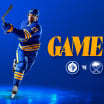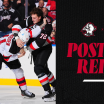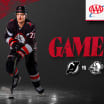Edreys Wajed asked himself a central question upon being commissioned to design a T-shirt for the Sabres that paid tribute to Black History Month.
"It's creative solution finding," Wajed said. "How do you say and pay tribute to Black history without writing the words 'Black history?'"
Wajed landed on a design that paid homage to Val James, who became the first Black player born in the United States to appear in an NHL game when he made his Sabres debut on Nov. 1, 1981. He incorporated design elements from the NBA's Buffalo Braves and made reference to Breaking Barriers, the local organization that will benefit from sales of the T-shirt.
Edreys Wajed discusses inspiration behind his 'Breaking Barriers' design
The artist's take on the Sabres logo pays homage to Val James
Inside the Sabres' "Breaking Barriers" design
The numbers "1981" and "26" are written within the Sabres logo as references to the year James made his debut and the number he wore in Buffalo. The colors and break within the charging Buffalo pay homage to the logo of the Braves, while the Sabres' usual crossed swords are replaced by Akofena, a symbol for courage and valor originating in Ghana.
The T-shirt is available now for individual purchase or as part of the newest Game Night to Go Pack
Wajed's art is woven into the fabric of Buffalo. He was among the artists who in 2017 collaborated on "The Freedom Wall" at Michigan Avenue and East Ferry Street, a collection of 28 vivid portraits depicting key figures to civil and human rights. His "Love Black" mural at 712 Main Street, commissioned by the Albright-Knox Art Gallery Public Art Initiative last year, is unmistakable in message.
But beyond his public collaborations, Wajed is a multi-faceted artist whose talents have included jewelry design, music production, barbering, and public speaking.
Sabres.com sat down with Wajed to discuss his career, his relationship with Buffalo, and his design for the Sabres. (The conversation has been edited.)
Inside the Sabres' "Breaking Barriers" design
How has Buffalo informed you as an artist?
What Buffalo has done for me is - I've said this before too because it's the only description that I have - it's given me a lot of grit. A lot of grit. Buffalo's been tough for me to make it as an artist. Buffalo, everybody knows, it's a rustbelt town, it's a blue-collar kind of deal, whatever. It's evolving into something else now, but never was I was encouraged to live the life of an artist, really.
It's like, "Man get a job." I'm just like, in my mind, 'Do you know how much work is required from me to do this kind of work that I'm doing?' Art doesn't get the same appreciation, generally.
So, what Buffalo's done for me is it has given me that grit to not stop. Every - I won't call it rejection, but every overlook, every oversight, when someone else leaves Buffalo and goes to another place and they find success. And I'm able to kind of provide for my family still being here? To me, that says if I can make it in Buffalo, I know I can make it any place else. Because it's very difficult to make it here. It's given me that kind of chip and attitude, in a sense.
Why was it important to you to stay?
Because I always want to win and lose on my terms. So, I decided to stay here. I decided to stay here because I believed that the town could benefit from me being here. Especially with the youth. I love reaching out and connecting with the youth. I used to be a teacher. If I moved someplace else, I'd have to learn the space and learn how I fit in. I'm already here, I know how to navigate, I know a lot of people, my network is pretty decent as far as how I can move about. So, I just felt like, if I'm going to make a difference, I'm gonna try and make a difference here.
This is the place that helped me build the character that I have and the person that I am. It just meant a lot for me to give it my all. And I will say, with that, at my age I'm like - I'm also at the point where I've given it my all. I've given it my all. So, in the event where I decide, 'OK, me and my family are picking up, we're going someplace else,' I can do that with a lovingness of like, 'I literally gave you everything I have, Buffalo.' Without me leaving with some sort of regret. While I'm here, I am giving it my absolute everything."
What was the inspiration behind the "Love Black" mural?
Man, so the Love Black Boys and Love Black Girls mural is spectacular. It's huge in scale, in its actual physical size, as well as in message. What that did is it just spelled it out. It spelled out for those not in the know or kind of on the fence - and it's not to persuade anybody. It's just, really, a knock on the head in very plain English about humanity. About checking your humanity. Like, how humane are you? Where do you stand with the things that especially Black children in America suffer and often don't get addressed?
I mean, we're dealing with children sometimes that go home and don't have parents, don't have meals or have walked by a homicide and yellow tape someplace. They're entering into a building, into a space and being yelled at to be on task, not knowing what this kid just went through. You don't know what this kid went through the past three nights or the hour before school. So, that's where that notion came from, from my experience being obviously a Black boy and growing into a Black man, raising two Black sons. That's where that came from. Love.
Love is a big capacity. It's something that should be practiced a lot more. We love a lot of things and we use the word very shallowly, in a shallow manner. To me, that is just to make people stop and pause and really assess themselves. That was the intention behind it.
And it came about as a collaboration with a student I used to work with, James Moffitt. A really good guy, I appreciate him. And lastly, a friend of mine, she's the one that actually gave me the idea to add the last part of it. So, I was already writing 'Love Black Boys,' because I have two children. And then she bought the shirt. And she was wearing the shirt when she was teaching and she was like, 'Even when they become men.' I was like, 'Oh.' It made me think deeper. I was like, 'Oh, crap.' So, just being observant and listening. I wasn't done learning with that.
Would you say there is a through line in your various works?
Yeah. The one thread is compassion. It's compassion and love. That's what it really is. No matter what it is, whether it's The Freedom Wall - I think people can feel the emotion and the personality in the faces coming off of that wall. The "Love Black," again, that mural, there's a feeling of love and compassion and warmth even though it's just black and white and stark. My personal work. Yeah, that's what I hope people take from it, I'll put it that way. Compassion and love.
How does your personal style play into your Sabres design?
That design particularly was challenging because it's creative solution finding. How do you say and pay tribute to Black history without writing the words 'Black history?' You know what I mean? How do you do that? So, I went through several iterations trying to convey, like, what does it mean?
We talked about pulling from all these different areas. I had to pull from my graphic design thoughts, had to pull from jewelry because there's swords in there, two swords which is an Adinkra symbol which is from Ghana. And so, I'm thinking about these two symbols. If I'm from African descent, I'd recognize those symbols. And then the relationship between the Sabres of the same logo. My task was to keep the logo intact, but still how do we pay homage to Black history? So, I just started putting these things together and pulling out things. It was a ball, man. It was a blast to put together.
I also used colors from the Buffalo Braves because one part I had to incorporate in there too was location and place, which is tied to Buffalo history because they used to play at The Aud. Both of them, the basketball team and the hockey team used to play at The Aud. That's why I brought the Braves' colors in there, to kind of pay homage by the design with the little separation in the Buffalo. So, I just put all these things together and I'm just happy the organization saw a fit and that it made sense.
What is the symbolism behind the swords?
It's the symbol that translates to valor or courage. It's a battle sword, too. So, talking about teams, they're battling for victory, right? And then valor and the courage. So, I put that in there particularly because, again, the similarities with the Sabres swords and also the courage that it took for the first African-American player to play in a predominantly white league and then also the courage of the Sabres to take that step as well, to bet on crossing that color line.
How much were you aware of Val James' story? How much have you learned?
I've gotten to learn a lot more once I got a little bit of the background from (Sabres vice president of community relations) Rich (Jureller), who I was talking to from the organization. Because I was familiar with Willie O'Ree. I actually painted a portrait of him years ago as a gift to somebody. I did not know about Val. So, we were just having this conversation about Val and of course I went and did a little digging.
His story was very akin to all the stories of firsts, you know? The first African-American president, the first female vice president. All the firsts, it's just the struggle they go through to be recognized. Now, obviously today it's harder to miss the firsts because where we are as a country, we're slowly growing toward this acceptance. But during that time, man, I only read a couple of instances about games he was played in and how he was treated. That's why the courage symbol was important.
Sabres Alumnus Val James' Historic Achievement
Why is the organization Breaking Barriers important to Buffalo?
It's them being mentors in front of young Black men, young Black boys that will grow up to be men. So, they're seeing through this mentorship, they're creating that thread and that that legacy of leaving an example. Because you can't aspire to something if you haven't seen it. So, that's what Breaking Barriers is from the work that I've seen them do. They expose them to opportunities, they expose them to alternate paths, and that's important for a child to be exposed to certain things and then to make a decision.
"I've been exposed to 12 different things, I'm good at four of them, but I only like two of them." OK. That gives them a path and a direction. Big ups, big shoutout to Breaking Barriers.
What do you want people to take from this design?
We were talking about comfortability and discomfort. In a predominantly white sport, the goal wasn't to out anybody, to say, "Hey! You should be paying more attention to Black history, Black accomplishments, Val James." It wasn't that kind of deal. How I work and my practice is to inform. It's to give you information. You do with it what you may, but once you're informed and you make a decision that's totally on you because you've decided to either engage further and open your mind up or you've decided to remain close-minded.
So, the design, I had to - using an ice term - I had to walk on really fragile ice in order to get to a spot that I felt like this is not intimidating, its' strong, it's powerful, and it brings awareness. I want it to be a great image, No. 1, because people do see things with their eyes first before they synthesize what the message is.
The first African-American in the NHL was a Buffalo Sabre. I think that's rich to have as a piece because it's going from 2021 and throwing that thread all the way back to then. So, you're kind of like joining these pieces together so that people understand it was and is a part of the Sabres that you cheer on today. You can't omit that part. When you're rocking the blue and the gold, that's a part of it too.
You could flip that too - the year 1981 is a reminder of how recent it was.
It's during somebody that you care about's lifetime, without question. There is somebody you know that may have even been at that game. So, that is a direct and a great example about how tangible it is. It's history, yes, but it's not an intangible history because the story exists and these people that were affected by it, they're still here.
Find more of Edreys' work on his website.


















